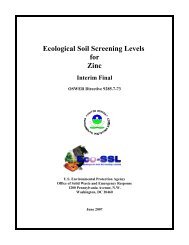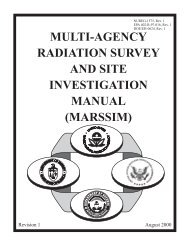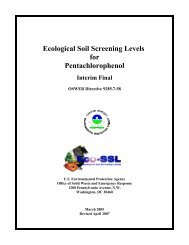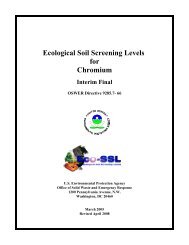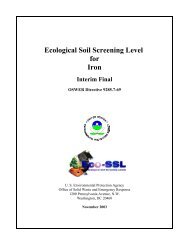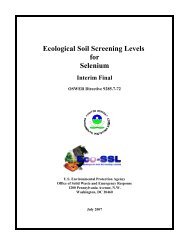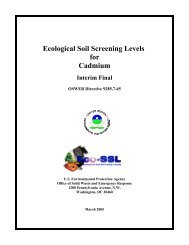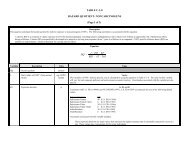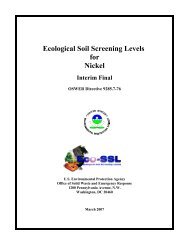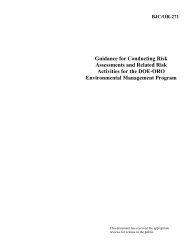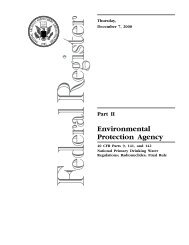Understanding Variation in Partition Coefficient, Kd, Values Volume II
Understanding Variation in Partition Coefficient, Kd, Values Volume II
Understanding Variation in Partition Coefficient, Kd, Values Volume II
Create successful ePaper yourself
Turn your PDF publications into a flip-book with our unique Google optimized e-Paper software.
5.0 Contam<strong>in</strong>ant Geochemistry and <strong>Kd</strong> <strong>Values</strong><br />
The important geochemical factors affect<strong>in</strong>g the sorption 1 of cadmium (Cd), cesium (Cs), chromium<br />
(Cr), lead (Pb), plutonium (Pu), radon (Rn), strontium (Sr), thorium (Th), tritium ( 3 H), and uranium (U)<br />
are discussed <strong>in</strong> this chapter. The objectives of this chapter are to: (1) provide a “thumb-nail sketch”<br />
of the key geochemical processes affect<strong>in</strong>g sorption of these contam<strong>in</strong>ants, (2) provide references to<br />
key experimental and review articles for further read<strong>in</strong>g, (3) identify the important aqueous- and solidphase<br />
parameters controll<strong>in</strong>g contam<strong>in</strong>ant sorption <strong>in</strong> the subsurface environment, and (4) identify, when<br />
possible, m<strong>in</strong>imum and maximum conservative K d values for each contam<strong>in</strong>ant as a function key<br />
geochemical processes affect<strong>in</strong>g their sorption.<br />
5.1 General<br />
Important chemical speciation, (co)precipitation/dissolution, and adsorption/desorption processes of<br />
each contam<strong>in</strong>ant are discussed. Emphasis of these discussions is directed at describ<strong>in</strong>g the general<br />
geochemistry that occurs <strong>in</strong> oxic environments conta<strong>in</strong><strong>in</strong>g low concentrations of organic carbon located<br />
far from a po<strong>in</strong>t source (i.e., <strong>in</strong> the far field). These environmental conditions comprise a large portion<br />
of the contam<strong>in</strong>ated sites of concern to the EPA, DOE, and/or NRC. We found it necessary to focus<br />
on the far-field, as opposed to near-field, geochemical processes for 2 ma<strong>in</strong> reasons. First, the near<br />
field frequently conta<strong>in</strong>s very high concentrations of salts, acids, bases, and/or contam<strong>in</strong>ants which often<br />
require unusual chemical or geochemical considerations that are quite different from those <strong>in</strong> the far<br />
field. Secondly, the differences <strong>in</strong> chemistry among various near-field environments varies greatly,<br />
further compromis<strong>in</strong>g the value of a generalized discussion. Some qualitative discussion of the effect of<br />
high salt conditions and anoxic conditions are presented for contam<strong>in</strong>ants whose sorption behavior is<br />
profoundly affected by these conditions.<br />
The distribution of aqueous species for each contam<strong>in</strong>ant was calculated for an oxidiz<strong>in</strong>g environment<br />
conta<strong>in</strong><strong>in</strong>g the water composition listed <strong>in</strong> Table 5.1 and the chemical equilibria code MINTEQA2<br />
(Version 3.10, Allison et al., 1991). The water composition <strong>in</strong> Table 5.1 is based on a “mean<br />
composition of river water of the world” estimated by Hem (1985). We use this chemical composition<br />
simply as a convenience as a proxy for the composition of a shallow groundwater. Obviously, there are<br />
significant differences between surface waters and groundwaters, and considerable variability <strong>in</strong> the<br />
concentrations of various constituents <strong>in</strong> surface and groundwaters. For example, the concentrations of<br />
1 When a contam<strong>in</strong>ant is associated with a solid phase, it is commonly not known if the contam<strong>in</strong>ant<br />
is adsorbed onto the surface of the solid, absorbed <strong>in</strong>to the structure of the solid, precipitated as a<br />
3-dimensional molecular coat<strong>in</strong>g on the surface of the solid, or absorbed <strong>in</strong>to organic matter.<br />
“Sorption” will be used <strong>in</strong> this report as a generic term devoid of mechanism to describe the partition<strong>in</strong>g<br />
of aqueous phase constituents to a solid phase. Sorption is frequently quantified by the partition (or<br />
distribution) coefficient, K d.<br />
5.1



